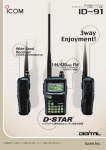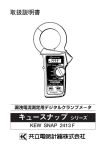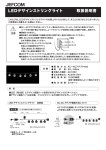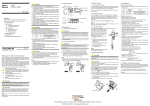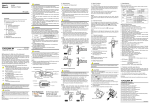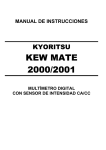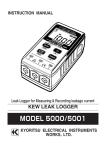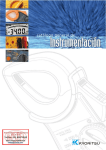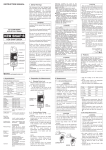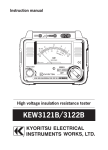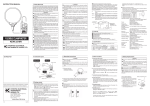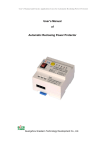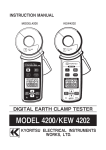Download KEW SNAP2413F.qxd
Transcript
INSTRUCTION MANUAL DIGITAL CLAMP METER KEW SNAP Series KEW SNAP 2413F KYORITSU ELECTRICAL INSTRUMENTS WORKS,LTD. Contents 1.Safety Warnings ………………………………………………………1 2.Features ………………………………………………………………4 3.Specifications …………………………………………………………5 4.Instrument Layout ……………………………………………………9 5.Operation 5−1 Preparation ……………………………………………………11 5−2 AC Current Measurement ……………………………………11 5−3 How to Use Peak Hold Function ……………………………14 5−4 How to Use The Frequency Selector Switch ………………16 5−5 How to Use Data Hold Function ……………………………17 5−6 Analogue Output How to Use Model 7073 Output Cord …17 6.Battery Replacement …………………………………………………19 7.Cleaning ………………………………………………………………20 8.Before Sending For Repair …………………………………………21 1.Safety Warnings Make sure to read through this instruction manual before using this instrument. ●The instrument has been designed, manufactured, and tested according to: IEC 61010, pollution degree2, CAT.Ⅲ, 300V IEC 61010, pollution degree2, CAT.Ⅱ, 600V This instruction manual contains warnings and safety rules which must be observed by the use to ensure safe operation of the instrument and to retain it in safe condition. ●The symbol indicated on the instrument means that the user must refer to related parts in the manual for safe operation of the instrument. Be sure to carefully read the instruction following each symbol in this manual. DANGER is reserved for conditions and actions that are likely to cause serious or fatal injury. WARNING is reserved for conditions and actions that can cause serious or fatal injury. CAUTION is reserved for conditions and actions that can cause bodily injury or instrument damage. WARNING ●Read through and understand instructions contained in this manual before starting using the instrument. ●Save and keep the manual handy to enable quick reference whenever necessary. ●In order to avoid injury, or damage to the instrument or the circuit under test, be sure to understand and follow all safety instructions contained in the manual. ●Be sure to use the instrument only in its intended applications and to follow measurement procedures described in the manual. ―1― Following symbols are used on the instrument and in the instruction manual. Attention should be paid to each symbol to ensure your safety. Refer to the instructions in the manual. This symbol is marked where the user must refer to the instruction manual so as not to cause personal injury or instrument damage. Indicates an instrument with double or reinforced insulation. Indicates that this instrument can clamp on bare conductors when measuring a voltage corresponding to the applicable Measurement category, which is marked next to this symbol. DANGER ●Never make measurement on a circuit above 600VAC. ●Do not attempt to make measurement in the presence of flammable gasses, fumes, vapor or dust. Otherwise, the use of the instrument may cause sparking, which can lead to an explosion. ●Transformer jaw tips are designed not to short the circuit under test. If equipment under test has exposed conductive parts, however, extra precaution should be taken to minimize the possibility of shorting. ●Never open the battery compartment cover when making measurement. ●Never attempt to use the instrument if its surface or your hand is wet. ●Do not exceed the maximum allowable input of any measurement range. ●Never try to make measurement if any abnormal conditions, such as broken Transformer jaws or case is noted. ●The instrument is be used only in its intended applications or conditions. Otherwise,Safety functions equipped with the instrument doesn't work, and instrument damage or serious personal injury may be caused. WARNING ●Never attempt to make any measurement if any abnormal conditions are noted, such as broken case, cracked test leads and exposed metal parts. ●Do not install substitute parts or make any modification to the instrument Return the instrument to Kyoritsu or your distributor for repair or re-calibration. ●Do not try to replace the battery if the surface of the instrument is wet. ―2― CAUTION ●Make sure that the function selector switch is set to an appropriate position before making measurement. ●Be sure to set the function selector switch to the “OFF” position after use. When the instrument will not be use for a long period of time, place it in storage after removing the battery. This is to avoid damage to the instrument by possible leakage from the battery. ●Do not expose the instrument to the direct sun, extreme temperatures or dew fall. ●Placing the instrument in temperatures of 50℃ or higher can cause the instrument's case to deform and result in operation failures. ●Never apply voltage to the OUTPUT terminal. the terminal is not electrically isolated from the internal circuits of the instrument. ○Measurement categories (Over-voltage categories) To ensure safe operation of measuring instruments, IEC61010 establishes safety standards for various electrical environments, categorized as CATⅠ to CATⅣ, and called measurement categories. Higher-numbered categories correspond to electrical environments with greater momentary energy, so a measuring instrument designed for CATⅢ environments can endure greater momentary energy than one designed for CATⅡ. CAT Ⅰ : Secondary electrical circuits connected to an AC electrical outlet through a transformer or similar device. CAT Ⅱ : Primary electrical circuits of equipment connected to an AC electrical outlet by a power cord. CAT Ⅲ : Primary electrical circuits of the equipment connected directly to the distribution panel, and feeders from the distribution panel to outlets. CAT Ⅳ :The circuit from the service drop to the service entrance, and to the power meter and primary over-current protection device (distribution panel). Incoming wire Interior wiring CAT.III CAT.IV Socket Transformer CAT.I ―3― CAT.II 2.Features KEW SNAP 2413F is a unique digital clamp meter for both very low current and high current measurements. Its shielded transformers jaws minimizes the effect of external stray magnetic field, enabling leakage current measurements. ●Measures from 0.1mA to 1000A AC and provides frequency response higher than 1kHz on all measuring ranges. Measurements also possible with approximately −7% accuracy at 20 kHz on 200mA range. ●Provides a frequency selector switch ― 50/60Hz or WIDE ―to turn on or off an incorporated low pass filter. This permits current measurement in mains fundamental frequency only or a wide range of frequencies, including those from such devices as inverters. ●Peak-hold facility with selectable response time of 10ms or 100 ms. ●Two-way analogue output terminal Provides AC voltage output proportional to the current under test for monitoring the waveform with an oscilloscope or measuring RMS current values with a true-RMS-reading instrument. Also convent ACA readings to DC voltage output for direct connection to such devices as a chart recorder. ●Data hold function to allow for easy readings in hard-to-reach locations. Display can be observed away from the conductor. ―4― 3.Specifications Measuring Ranges and Accuracy ●AC Current Accuracy Ranges WIDE 50/60Hz ±1.0%rdg±2dgt (50/60Hz) ±3.0%rdg±2dgt (40∼1kHz) ±1.5%rdg±2dgt 0∼199.9A ±1.5%rdg±2dgt (50/60Hz) ±3.5%rdg±2dgt (40∼1kHz) ±2.0%rdg±2dgt 0∼500A ±1.5%rdg±2dgt (50/60Hz) ±3.5%rdg±2dgt (40∼1kHz) ±2.0%rdg±2dgt 501∼1000A ±5%rdg (50/60Hz) ±10%rdg (40∼1kHz) ±5.5%rdg 200mA 0∼199.9mA 2A 0∼1.999A 20A 0∼19.99A 200A Frequency Range Response Time Limit for Measurements Continuous 1000A 10min. ※Refer to Figure 1 for frequency characteristics. ●Effect of External Stray Magnetic Field 10mA AC max. in proximity to a 10mm-dia conductor carrying 100A AC. ●Effect of Residual Current 10mA AC max. when clamping on two 10mm-dia conductors, each carrying supply or return 100A AC current. ―5― Analogue Output (Output impedance: Approx. 1kΩ) ●AC Output Range Measuring Range 200mA 0∼200mA 2A 0∼2A 20A 0∼20A 200A 0∼200A 1000A AC Output Voltage 0∼200mV Accuracy ±2%rdg ±2.5%rdg 0∼500A 0∼50mV ±3%rdg 501A∼1000A 50∼100mV ±5%rdg *Voltage proportional to the current under test is output with “WIDE”frequency characteristics regardless of the setting of the frequency Selector or peak hold switch. ―6― ●DC Output Ranges AC Input Current 200mA 0∼200mA 2A 0∼2A 20A 0∼20A 200A 0∼200A 1000A 0∼500A DC Output Voltage 0∼200mV 0∼50mV 501A∼1000A 50∼100mV Accuracy (Frequency Range) Freq. Selector Freq. Selector Switch at 50/60Hz Switch at Position WIDE position ±3%rdg ±3.5%rdg ±3.5%rdg ±4.0%rdg ±5%rdg ±5.5%rdg ±7%rdg ±7.5%rdg *DC voltage is output in proportion to the display reading, which reflects frequency selector or peak hold switch position−200mV DC for 2000 count reading. Operating System Display Range selection Overrange Indication Response Time Sample Rate Data Hold Location for use Temperature & Humidity for Specified Accuracy Storage Temperature & Humidity Operating Temperature & Humidity :Dual Integration :Field effect 3 −1/2 digit liquid crystal display with maximum count of 1999 :Manual :“1”is displayed on the highest digit except for 1000A AC range. :Approx. 1 seconds :Approx. 3 times per second :Available on all ranges :Indoor use, Altitude up to 2000m :23℃±10℃, relative humidity up to 85% without condensation :−10∼50℃, relative humidity up to 80% without condensation :0∼40℃,relative humidity up to 85% without condensation ―7― Power Source Low Battery Warning Current Consumption Standard(Safety) (EMC) Overload Protection Withstand Voltage Insulation Resistance Conductor Size Dimensions/Weight Accessories Optional Accessories Peak Hold :One 6 F22 or equivalent battery :“B”symbol is shown on the display. :Approx. 5mA max. :IEC61010-1 IEC61010-2-032 CAT.Ⅲ,AC300V,Pollution degree 2 :IEC61326 EN55022 :1500A AC max for 1 minute :3700V AC for 1 minute between electrical circuit and housing cases :10MΩ or greater at 1000V between electrical circuits and housing cases or metal parts of jaws :Approx. 68mm diameter max. :250(L)×130(W)×50(D)mm×. 570g (including battery ) :6F22 battery Carrying case Instruction manual :Model 7073 two-way output cord :Response time selectable from approx. 10ms and 100ms. 1/√2 of the peak current is displayed, which means an RMS reading will be obtained when current having sinusoidal waveform in measured. Peak hold reading varies by approximately ±1% max of full scale in the first minute at 23℃±10℃ and relative humidity of 75% without condensation. ―8― 4.Instrument Layout ⑩ Fig.2 ―9― ① LCD Field effect liquid crystal display with maximum indication of 1999. Function symbol(mA, A) and decimal point automatically appear as the function / range switch is turned. “B”is displayed on the lower left corner for low battery warning and “1”is displayed only at the highest digit for overrange indication. ② Data Hold Button Allows for easy reading in dimly lit or hard-to-reach-locations. The display can be observed away from the conductor after pushing in the button. Data hold can be released by pushing the button again after the reading is taken. ③ Two-way Analogue Output Terminal AC current picked up by transformer jaws (7) is converted and output as AC and DC voltage output. (See Analogue Output in section 3, Specifications.) Insert output cord Model 7073 into this terminal for monitoring waveform with an oscilloscope, making RMS measurements or connecting to a recorder. ④ Safety Hand Strap prevents the instrument from slipping off the hand during use. ⑤ Power Function/Range Switch Selection function and range. It is also used to turn power on or off. CAUTION Always set the Power Function/Range Switch to the OFF position after use. ⑥ Jaw Trigger Operates transformer jaws (7). Press to open the jaws. ⑦ Transformer Jaws Pick up the current flowing through the conductor. ⑧ Peak Hold Selector Switch Selects 10ms or 100ms response time. Set the switch back to the OFF position to release peak hold or make normal measurements. ⑨ Frequency Selector Switch Makes frequency response selection. ⑩ Barrier It is a part providing against electrical shock and ensuring the minimum required air and creepage distances. ― 10 ― 5.Operation 5−1 Preparation (1) To Check battery set the function/range switch (5) To the desired position. If the display is clear without symbol “B”showing, battery voltage is sufficient. If the display blanks or“B”is indicated, replace the battery in accordance with the battery replacement procedures as described in section 6. Note:“B”also appears on the display when the battery becomes exhausted during use. Replace with a new battery. (2) Make certain that the data hold button is in the off position − not pressed down. If a measurement is made with the data hold button pressed in, the display remains locked irrespective of input. 5−2 AC current Measurement WARNING ●Do not make measurement on a circuit above 600V AC. ●Transformer jaw tips are designed not to short the circuit under test. If equipment under test has exposed conductive parts, however, extra precaution should be taken to minimize the possibility of shorting. ●Do not make measurement with the battery compartment cover removed from the instrument. ●Keep your fingers and hands behind the barrier during measurement. ― 11 ― CAUTION ●Transformers jaws , especially their tips, have been precisely adjusted to obtain maximum accuracy. Take sufficient care to avoid shock, vibration or excessive force when handing the instrument. ●When a foreign substance is stick in the jaw tips or they cannot properly engage, the transformer jaws do not fully close. In such a case, do not release the jaw trigger suddenly or attempt to close the transformer jaws by applying external force. Make sure that the jaws close by themselves after removing the foreign substance or making them free to move. ●The maximum size of conductor that can be measured is approx. 68mm in diameter. An accurate measurement cannot be made on a conductor larger than this, because the transformer jaws cannot be fully closed. ●Frequency selector switch (9) is designed to select the 50/60Hz and“WIDE”frequency ranges. For further details, refer to section 5-4 for operation of the frequency selector switch. ●The transformer jaws may buzz when measuring large current. This has no effect on the instrument's performance or safety. (1) Set the function/range switch to the desired position. Do not exceed the maximum allowable input current for the selected range. (2) For normal measurement, press the jaw trigger to open the transformer jaws and clamp onto one conductor only. See Figure 3. Earth leakage current or small current that flow through a grounded wire can also be measured by this method. (Fig. 4) If is recommended that the conductor is placed at the center of the closed transformer jaws. (3) To measure out of balance leakage current, clamp onto all conductors except a grounded wire. The leakage current measure will be indication on the display. (Fig.4&Fig.5) ― 12 ― Fig.3 Normal AC Current Measurements Fig.4 Earth Leakage Current Measurements Single-Phase 2-wire system (in 3-wire system with neutral clamp onto all 3 wire) 3-phase 3-wire system. (in 4-wire system with neutral clamp onto all 4 wire) Fig.5 Measurements out of balance Leakage Note:When measuring large current, observe the time limit specified in section 3, Specifications. Otherwise, the transformers jaws may overheat, resulting in damage to the instrument. ― 13 ― 5−3 How to Use Peak Hold Function 10ms or 100ms response time can be selected for peak hold measurement. Make selection according to your application needs. (1) With the transformer jaws clamped onto the conductor under test, slide the peak hold switch from the OFF position to the desired peak response time position. (2) The peak hold display reads 1/√2 of the peak current value. Therefore, an RMS reading will be obtained when the current under test has a sinusoidal waveform. I (3) Slide the peak hold switch back to the OFF position for a reset. Note 1:KEW SNAP 2413F uses an analogue peak hold circuit to ensure a quick response to input current. Because of the nature of this circuit, the peak hold reading may gradually fall or, in a rare case, rise with time. This is likely to be apparent when the instrument is used in a high temperature and high humidity environment. Therefore, the instrument will not be suitable for making peak measurement over an extended period of time. In case of such a need, connect a recorder to the instrument via the analogue output terminal. ― 14 ― Note 2:If it is necessary to read the display away from the conductor in a peak hold measurement, press the data hold switch (2) first and then remove the instrument from the conductor. Otherwise, the peak hold reading may be higher than the actual value due to the electrical noise caused by the opening and closing of the transformer jaws. Press the data hold switch again for a reset. (4) Difference between 10ms and 100ms Peak Response Time The peak hold circuit in this instrument charges the peak-hold capacitor after rectifying the input waveform. The time for the voltage of the capacitor to reach its peak value varies according to its capacitance and the output impedance of the charging circuit. KEW SNAP 2413F sets the time for the voltage of the capacitor to reach 90% of its peak value to 10ma or 100ms by switching between two output impedances. Refer to Figure 7 for further details. I For instance, select the 10ms response time when measuring a surge current that will occur when a power supply device is switched on. The 100ms response time is recommended for measuring the starting current of a motor or similar equipment. A stable measurement can be made on the 100ms second response time setting as the peak hold circuit does not readily respond to the surge current. ― 15 ― 5−4 How to Use The Frequency Selector Switch KEW SNAP 2413F has a very good frequency response because of the electromagnetic property of its transformers jaws. Therefore, it measured, AC current not only of fundamental frequency of 50Hz or 60Hz, but of high frequencies and harmonics superimposed on the fundamental frequency. To eliminate these superimposed components and measure only in the fundamental frequency, KEW SNAP 2413F has a high-cut filter circuit, which can be activated by activated by setting the frequency selector switch to the '50/60Hz' position. The high-cut filter has a cut-off frequency of approx. 100Hz and an attenuation characteristics of approx. −24 dB/octave. Note:−24dB/octave means that the magnitude of a signal declines by a factor of 16 when its initial frequency doubles. The frequency selector switch has the following two positions. ●WIDE(40Hz−over 1kHz): Covers a wide frequency band from mains supply to high frequencies generated by such equipment as inverters. ●50/60Hz(40−Approx.100Hz): Filters out high frequency components to restrict measurement in mains frequency band. Note:Selection with the frequency selector switch dose not apply to AC output of the two-way analogue output. DC output of the twoway analogue output reflects the frequency selector switch setting. Refer to Figure. 1 for frequency characteristics. ― 16 ― 5−5 How to Use Data Hold Function Push in the Data Hold button to freeze the reading. This is especially useful for taking a reading in a dimly lit or hard-to-reach locations. The display can be observed away from the conductor. Push the button again to release the reading. 5−6 Analogue Output: How to Use Model 7073 Output Cord AC and DC output can be obtained by inserting optional Model 7073 output cord into the two-way analogue output terminal (3). AC Output Can be monitored by connecting a digital multimeter to analogue output terminal or observed as a waveform by connecting an oscilloscope. For true RMS measurements, connect a true-RMS-reading digital multimeter. DC Output: Can be monitored by connecting a digital multimeter, or a recorder, which enables many hours of monitoring. See Figure 8. With the 2413F in the peak hold mode, DC voltage corresponding to 1/√2 of a peak current value can be held and output. Refer to section 5-3, How to Use Peak Hold Function. ― 17 ― KEW SNAP 2413F ― 18 ― 6.Battery Replacement Replace the battery when B symbol appears on the LCD display. (1) Set the function/range switch to the OFF position. (2) Unscrew and remove the battery compartment cover from the rear of the case. (3) Install a new 9V battery of type 6F22 or equivalent observing correct polarity. (4) Screw the battery compartment cover. WARNING Never replace the battery during measurement. ― 19 ― 7.Cleaning Use a damp cloth detergent for cleaning the body of the instrument. To avoid possible deforming or discoloring, do not use solutions containing solvent. CAUTION ●Never use paint thinner, benzene or other solutions containing solvent for cleaning the instrument. Otherwise, deforming or discoloring of the instrument body may result. ●Handle the instrument with care and follow the instructions in order to maintain it in good condition for a long period of time. ― 20 ― 8.Before Sending for Repair Use the following troubleshooting guide for hints on problems with instrument operation. Condition Possible Cause Display blanks after power- Battery on. is Remedy improperly Install the battery correctly. installed. Replace the battery. Battery is exhausted. Display reading remains Data hold button is pressed Release data hold button. frozen. in. Set peak hold switch to Peak hold switch is at ON OFF position. position. Transformer jaws buzz when measuring large This is not a failure. ─── current. The lowest digit of reading This is not a failure. is unstable. The instrument is highly ─── accurate, so it senses slight variations in the current under test. Output cord (Model 7073) The cord is open is circuit. dose not output voltage. ― 21 ― Check the cord for an open circuit. DISTRIBUTOR Kyoritsu reserves the rights to change specifications or designs described in this manual without notice and without obligations. 92―1433A 04―10
























